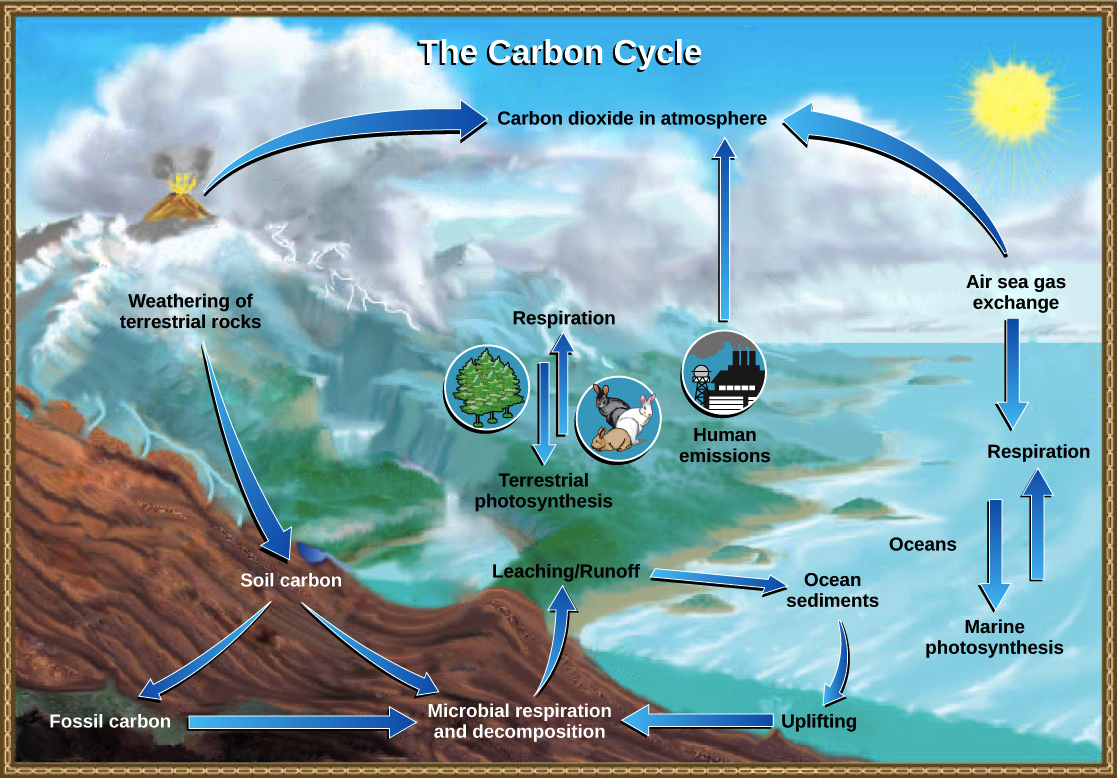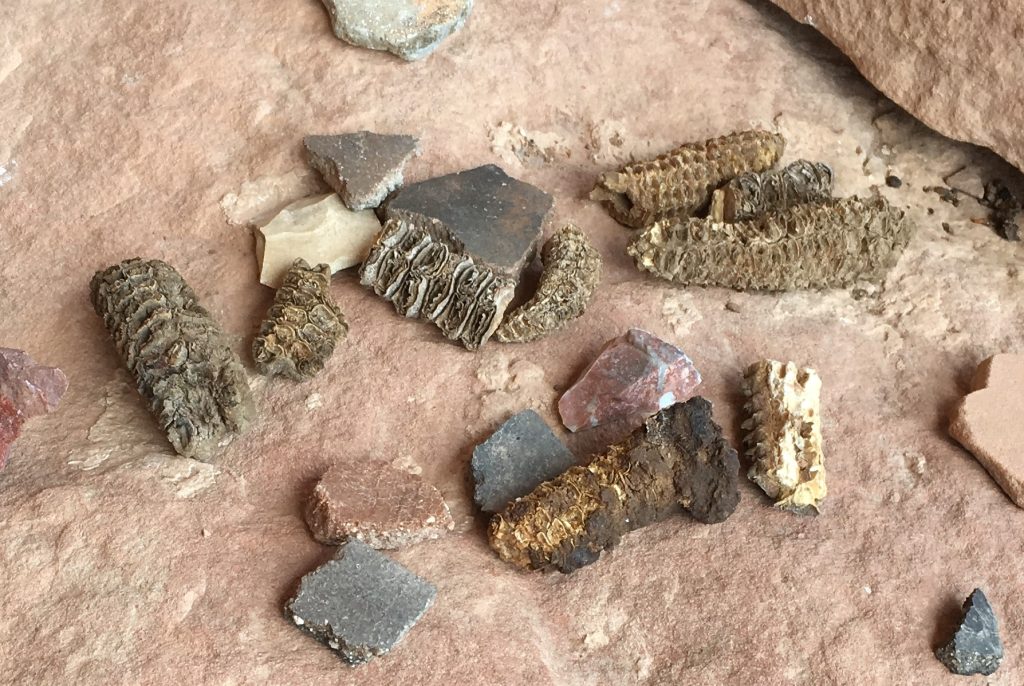13.4 Weathering, Soils, and Climate Change
Katherine J. Megivern
We have a history of wasting soil, critical to all life, on a massive scale. Besides losing soil itself, negative atmospheric changes ride on the shirttails of its loss. But with application of a deeper knowledge today of the physiology of soil, there’s also hope for both our planet’s atmosphere and its soil…and for the rest of the biosphere. Carbon is key.
Carbon
Earth has two important carbon cycles. One is the biological one, also called the short carbon cycle, wherein living organisms, mostly plants, consume carbon dioxide from the atmosphere to make their tissues, and then, after they die, that carbon is released back into the atmosphere when they decay over years or decades.
The second is the geologic carbon cycle, also called the long carbon cycle. A small proportion of biological-cycle carbon becomes buried in sedimentary rocks during the slow formation of coal, as tiny fragments and molecules in organic-rich shale. Another small proportion is incorporated in shells and other parts of marine organisms that in time become limestone. Both of these outcomes, coal and limestone, become part of the geological carbon cycle, a cycle that involves a majority of Earth’s carbon but operates only very slowly.
The carbon cycle below shows some of the various movements of carbon in the cycle.

- Organic matter from plants is stored in peat, coal, and permafrost for thousands to millions of years.
- Weathering of silicate minerals converts atmospheric carbon dioxide to dissolved bicarbonate, stored in the oceans for thousands to tens of thousands of years.
- Marine organisms convert dissolved carbon to calcite, which is stored in carbonate rocks for tens to hundreds of millions of years.
- Carbon compounds are stored in sediments for tens to hundreds of millions of years; some end up in petroleum deposits.
- Carbon-bearing sediments are transferred to the mantle, where the carbon may be stored for tens of millions to billions of years.
- During volcanic eruptions, carbon dioxide is released back to the atmosphere, where it is stored for years to decades.
During much of Earth’s history, the geological carbon cycle has been balanced, with carbon being released by volcanism at approximately the same rate that the other processes store it. Under these conditions, the climate remains relatively stable.
During some periods of Earth’s history, that balance has been upset. This can happen during prolonged periods of higher than average volcanism. One example is the eruption of the Siberian Traps at around 250 Ma (million years ago), which appears to have led to strong climate warming over a few million years.
A carbon imbalance is also associated with significant mountain-building events. For example, the Himalayan Range was formed between about 40 and 10 million years ago. Over that period, and still today, the rate of weathering on Earth has been enhanced because those mountains are so high, and the range is so extensive. The weathering of these rocks, most importantly the hydrolysis of feldspar, has resulted in the consumption of atmospheric carbon dioxide and transfer of the carbon to the oceans and ocean-floor carbonate minerals. The steady drop in carbon dioxide levels over the past 40 million years, which led to the Pleistocene glaciations, is partly attributable to the Himalayan Range formation.
Climate Change
Another form of carbon-cycle imbalance is happening today on a very rapid time scale. We are in the process of extracting vast volumes of fossil fuels (coal, oil, and gas) that were stored in rocks over the past several hundred million years, and converting these fuels to energy and carbon dioxide. By doing so, we are changing the climate faster than has ever happened in the past.
Climate change, with its accompanying increase in frequency and strength of storms, increases wind and water erosion of soil. What is lost?
The Rest of the Soil Story
Healthy soils are a remarkable resource. In under 12 minutes, this final video of the chapter illustrates and describes the hidden interrelationships between organisms in a healthy soil that are essential for sustainable agriculture and a sustainable Earth. Your goal in watching is to be able to:
- Briefly summarize the history of our use of synthetic fertilizers.
- Describe the effects of long-term use of synthetic fertilizers.
- Explain how the use of heavy farm equipment and deep planting are detrimental to plant growth.
- Describe the benefits of shallow cultivation.
- Explain how synthetic fertilizers have necessitated the use of pesticides.
- Describe the details of the role of plants, rhizobacteria, and mycorrhizal fungi in their symbiotic relationship.
- Summarize the importance of humus and its relationship to carbon dioxide.
- Describe how synthetic nitrogen fertilizer results in an increase in carbon dioxide in our atmosphere.
- Summarize the best way to improve soil.
- Explain how healthier soil might increase the nutritional value of our food.
Video 13.4.1. PHC Film: Soil is a Living Organism. (11:55) This video illustrates and describes the hidden interrelationships between organisms in a healthy soil that are essential for sustainable agriculture and a sustainable Earth.
So our soils must be healthy. And it should go without saying that our soils need to be present; that is, erosion must be controlled. Soil grows our plants, the foundation of Earth’s food webs, and soils can store more carbon than the atmosphere can.
Biosequestration, capturing carbon in the soil, integrates the knowledgeable use of plants and effective farming/ranching techniques. These techniques include less plowing, no-till planting, off-season cover crops, incorporation of perennial prairie plants, and regenerative grazing. These methods are aligned with the knowledge that soil is a living organism. Supporting economic programs and incentives could really bolster these efforts to reverse climate change.
Backyard Geology: Indigenous Agriculture in the U.S. Southwest
With intensifying drought and high temperatures, many farming in the U.S. Southwest are struggling. The indigenous people know that their ancestors were able to produce food in the U.S. Southwest under similarly trying circumstances. But in so many cases, the indigenous methods were replaced by Euro-American methods upon settlement, and even the seeds were often replaced by varieties familiar to the newcomers.
But some native seeds were saved, if for no other reason than that they were sacred. These are now part of the Zuni Community Seed Bank. They are the results of breeding varieties adapted to drought conditions. Corn for example exhibits long roosts to reach deep water, small plants, but many ears per plant.
And though efforts were made to erase the native ways from memory, some people remembered and passed on the knowledge accumulated from centuries of habitation. Researchers now urgently seek this information on the ancient plants and methods.

Some examples of what researchers are learning can be found in their work with the Zuni and Hopi tribes in northwest New Mexico and northeast Arizona, one of the driest areas of the U.S. These tribes, growing corn, beans, and other vegetables, would not irrigate a single parcel of land year after year, but were practicing runoff agriculture that included crop rotation. They would relocate fields to a series of locations at the base of mesas to where storm runoff would flow. They would also channel the water and incorporate small dams as needed. Nutrients were spread, and the canals and dams slowed the velocity of the water, reducing erosion.
Treating Earth, seeds, and water as sacred is key. Keeping in mind the people to come seven generations in the future is also critical and basic, as it is for so many indigenous ventures across the U.S.
Composting
Let’s consider these facts:
- Biosequestration captures carbon in the soil
- Soil can hold more carbon than the atmosphere, and soil is the preferred location for excess carbon
- Carbon is a component of many molecules in plants
- Many animals eat plants
- Humans eat plants, they eat animals, they garden, and they trim trees and other plants.
- Humans produce a lot of organic (carbon-containing) waste that ends up in landfills.
While it may seem that putting organic waste in a landfill is perfect, burying carbon, it actually releases methane, a greenhouse gas more potent in climate change than carbon dioxide. A good solution to this dilemma exists!
Video 13.4.2. Why is Composting Good for the Environment?(1:38) This video explains the advantages of composting and problems with throwing organic waste into waste bins and having it end up in a landfill.
Composting allows organic waste to decompose in the presence of oxygen. Methane will not be produced. What is produced is a quality soil that can be added to home yards and gardens. Basically, composting just requires layers of wet and dry compost and the turning of those layers from time to time. There are a number of good sites explaining how to compost. Examples of sites with instructions and more background information:
Some areas collect organic waste separately from other waste and compost it. The San Francisco area is a leader in this, with composting an integral part of their model waste management system.
Video 13.4.3. How San Francisco Became a Global Leader in Waste Management. (5:25) This video is an excellent overview of San Francisco’s waste management system, including composting and use of the resulting quality soil/fertilizer.

